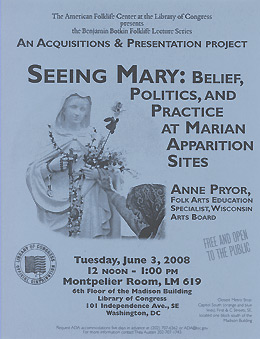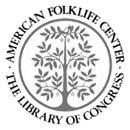| |
|||
|
|
The American Folklife Center at the Library of Congress June 3, 2008 Event Flyer Seeing Mary:
|

|
For Roman Catholics, it is a rare and highly valued supernatural phenomenon when a heavenly being makes known its physical presence on earth. Reports exist of Jesus, his mother Mary, angels, and saints visiting mystics, seers and common folk throughout the two-thousand-year history of the Catholic church.
Within this larger tradition is the more specific Marian apparition, when Mary, the Blessed Mother, appears to a human being. The seer is typically an ordinary person, someone without specialized training, knowledge or devotion to Mary. The new visionary is typically confused or frightened by the otherworldly experience of communing with the divine and turns to family, friends or a priest for help. From there, word spreads and, if Mary promised to return at a set time and place, people gather. So is born a Marian apparition; something that started as a personal supernatural experience becomes a public community-based event.
What happens in a community where a public apparition of Mary occurs? Physically, practical concerns rub up against spiritual ones. In the short term, managing the logistics of hundreds or thousands of pilgrims suddenly attending the next event becomes a difficult challenge for the visionary’s supporters and local authorities. Their concerns might conflict with believers’ goal of access to the site. For pilgrims, the place of the apparition is now sacred ground; Mary’s presence transformed it into a space to be revered. Many seek to honor this transition through acts of devotion and installation of sacred symbols at the heart of the site.
Some serial apparitions end within days; others carry on for decades. Believers continue to come to the now sacred site not only during the actual apparitions but at other times as well. Many hope to more easily connect with heaven through residual grace that has remained after Mary’s presence blessed the site. How does a community deal with continued pilgrimage, especially when the apparition site has other everyday functions that are not aligned with hosting pilgrims?
As an apparition continues to unfold, Catholics in the community decide whether to believe or not in its authenticity. To do this, they turn to both official and popular means of discernment. In the rare event that the local bishop launches an investigation, would-be believers can wait for that judgment. Most often, however, they turn to their own criteria: whether this apparition compares well with the few approved by the church, whether they experience direct signs from heaven themselves, whether reputable priests support the visionary, and whether the messages Mary delivers to the visionary seem aligned with church teachings. They also rely on narrative, the personal experience stories they hear from others about the apparitions and their outcomes. Many legends about Mary’s direct intervention are retold through the discernment process.
Apparitions produce messages; when Mary visits a person, she does so to deliver a warning or teaching. The shape of her messages varies because of the filter of each visionary, and the tone can range from apocalyptic to comforting. All the messages share a sense of urgency and an impulse toward reform. Examining apparition messages can reveal the worries felt by Marian devotees, who are typically politically conservative. For example, Marian apparition messages from the 1950s are concerned with the threat of communism while those from the late 1990s deal more with millennial fears.
Each apparition community works out a way for the visionary to deliver Mary’s messages to those gathered. In some, the visionary repeats the message directly to the crowd; in others, a review board of priests first approves the message before distribution. In either situation, the patriarchal structure of the Catholic church exerts an unacknowledged pressure on the visionary, who is in most cases a woman. The act of an
unordained woman publicly revealing words that come directly from heaven has the potential to be subversive. But these visionaries are typically orthodox Catholics who willingly acquiesce to a role of obedience to their superiors. How does the reform Mary calls for in her messages relate to the role of women in the church?
In this lecture, we will look at specific apparition events that have occurred in the United States since 1950, all of which are in different phases of their development today: Necedah, Wisconsin; Conyers, Georgia; Cold Spring, Kentucky; Emmitsburg, Maryland. Looking at these selected sites will explain the context of the issues discussed above and reveal Marian apparitions as complex social phenomena that embody issues of politics, power, devotion and belief.
Anne Pryor
Folk Arts Education Specialist
Wisconsin Arts Board

The American Folklife Center was created by Congress in 1976 and placed at the Library of Congress to "preserve and present American Folklife" through programs of research, documentation, archival preservation, reference service, live performance, exhibition, public programs, and training. The Center includes the American Folklife Center Archive of folk culture, which was established in 1928 and is now one of the largest collections of ethnographic material from the United States and around the world. Please visit our web site.
| ||||
